Jiakang Yuan
MME-Reasoning: A Comprehensive Benchmark for Logical Reasoning in MLLMs
May 27, 2025Abstract:Logical reasoning is a fundamental aspect of human intelligence and an essential capability for multimodal large language models (MLLMs). Despite the significant advancement in multimodal reasoning, existing benchmarks fail to comprehensively evaluate their reasoning abilities due to the lack of explicit categorization for logical reasoning types and an unclear understanding of reasoning. To address these issues, we introduce MME-Reasoning, a comprehensive benchmark designed to evaluate the reasoning ability of MLLMs, which covers all three types of reasoning (i.e., inductive, deductive, and abductive) in its questions. We carefully curate the data to ensure that each question effectively evaluates reasoning ability rather than perceptual skills or knowledge breadth, and extend the evaluation protocols to cover the evaluation of diverse questions. Our evaluation reveals substantial limitations of state-of-the-art MLLMs when subjected to holistic assessments of logical reasoning capabilities. Even the most advanced MLLMs show limited performance in comprehensive logical reasoning, with notable performance imbalances across reasoning types. In addition, we conducted an in-depth analysis of approaches such as ``thinking mode'' and Rule-based RL, which are commonly believed to enhance reasoning abilities. These findings highlight the critical limitations and performance imbalances of current MLLMs in diverse logical reasoning scenarios, providing comprehensive and systematic insights into the understanding and evaluation of reasoning capabilities.
NovelSeek: When Agent Becomes the Scientist -- Building Closed-Loop System from Hypothesis to Verification
May 22, 2025
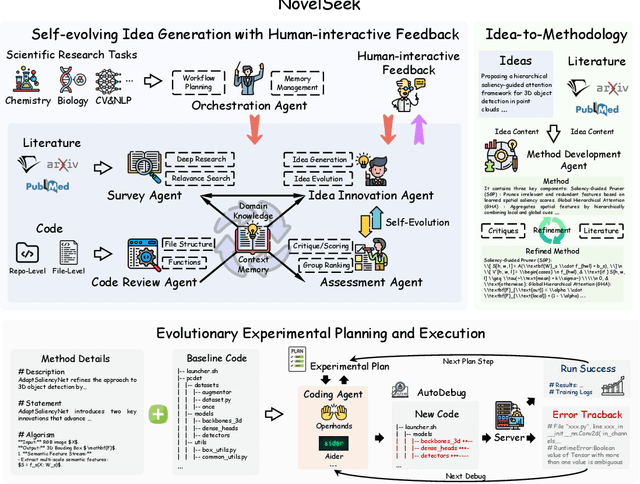

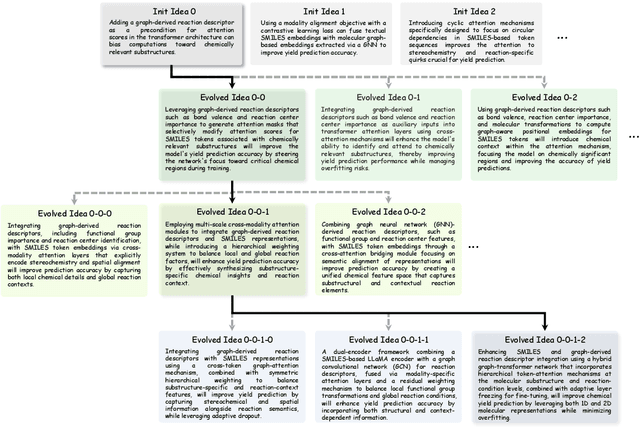
Abstract:Artificial Intelligence (AI) is accelerating the transformation of scientific research paradigms, not only enhancing research efficiency but also driving innovation. We introduce NovelSeek, a unified closed-loop multi-agent framework to conduct Autonomous Scientific Research (ASR) across various scientific research fields, enabling researchers to tackle complicated problems in these fields with unprecedented speed and precision. NovelSeek highlights three key advantages: 1) Scalability: NovelSeek has demonstrated its versatility across 12 scientific research tasks, capable of generating innovative ideas to enhance the performance of baseline code. 2) Interactivity: NovelSeek provides an interface for human expert feedback and multi-agent interaction in automated end-to-end processes, allowing for the seamless integration of domain expert knowledge. 3) Efficiency: NovelSeek has achieved promising performance gains in several scientific fields with significantly less time cost compared to human efforts. For instance, in reaction yield prediction, it increased from 27.6% to 35.4% in just 12 hours; in enhancer activity prediction, accuracy rose from 0.52 to 0.79 with only 4 hours of processing; and in 2D semantic segmentation, precision advanced from 78.8% to 81.0% in a mere 30 hours.
OmniCaptioner: One Captioner to Rule Them All
Apr 09, 2025Abstract:We propose OmniCaptioner, a versatile visual captioning framework for generating fine-grained textual descriptions across a wide variety of visual domains. Unlike prior methods limited to specific image types (e.g., natural images or geometric visuals), our framework provides a unified solution for captioning natural images, visual text (e.g., posters, UIs, textbooks), and structured visuals (e.g., documents, tables, charts). By converting low-level pixel information into semantically rich textual representations, our framework bridges the gap between visual and textual modalities. Our results highlight three key advantages: (i) Enhanced Visual Reasoning with LLMs, where long-context captions of visual modalities empower LLMs, particularly the DeepSeek-R1 series, to reason effectively in multimodal scenarios; (ii) Improved Image Generation, where detailed captions improve tasks like text-to-image generation and image transformation; and (iii) Efficient Supervised Fine-Tuning (SFT), which enables faster convergence with less data. We believe the versatility and adaptability of OmniCaptioner can offer a new perspective for bridging the gap between language and visual modalities.
Consistency-aware Self-Training for Iterative-based Stereo Matching
Mar 31, 2025Abstract:Iterative-based methods have become mainstream in stereo matching due to their high performance. However, these methods heavily rely on labeled data and face challenges with unlabeled real-world data. To this end, we propose a consistency-aware self-training framework for iterative-based stereo matching for the first time, leveraging real-world unlabeled data in a teacher-student manner. We first observe that regions with larger errors tend to exhibit more pronounced oscillation characteristics during model prediction.Based on this, we introduce a novel consistency-aware soft filtering module to evaluate the reliability of teacher-predicted pseudo-labels, which consists of a multi-resolution prediction consistency filter and an iterative prediction consistency filter to assess the prediction fluctuations of multiple resolutions and iterative optimization respectively. Further, we introduce a consistency-aware soft-weighted loss to adjust the weight of pseudo-labels accordingly, relieving the error accumulation and performance degradation problem due to incorrect pseudo-labels. Extensive experiments demonstrate that our method can improve the performance of various iterative-based stereo matching approaches in various scenarios. In particular, our method can achieve further enhancements over the current SOTA methods on several benchmark datasets.
Lumina-Image 2.0: A Unified and Efficient Image Generative Framework
Mar 27, 2025Abstract:We introduce Lumina-Image 2.0, an advanced text-to-image generation framework that achieves significant progress compared to previous work, Lumina-Next. Lumina-Image 2.0 is built upon two key principles: (1) Unification - it adopts a unified architecture (Unified Next-DiT) that treats text and image tokens as a joint sequence, enabling natural cross-modal interactions and allowing seamless task expansion. Besides, since high-quality captioners can provide semantically well-aligned text-image training pairs, we introduce a unified captioning system, Unified Captioner (UniCap), specifically designed for T2I generation tasks. UniCap excels at generating comprehensive and accurate captions, accelerating convergence and enhancing prompt adherence. (2) Efficiency - to improve the efficiency of our proposed model, we develop multi-stage progressive training strategies and introduce inference acceleration techniques without compromising image quality. Extensive evaluations on academic benchmarks and public text-to-image arenas show that Lumina-Image 2.0 delivers strong performances even with only 2.6B parameters, highlighting its scalability and design efficiency. We have released our training details, code, and models at https://github.com/Alpha-VLLM/Lumina-Image-2.0.
Bidirectional Prototype-Reward co-Evolution for Test-Time Adaptation of Vision-Language Models
Mar 12, 2025Abstract:Test-time adaptation (TTA) is crucial in maintaining Vision-Language Models (VLMs) performance when facing real-world distribution shifts, particularly when the source data or target labels are inaccessible. Existing TTA methods rely on CLIP's output probability distribution for feature evaluation, which can introduce biases under domain shifts. This misalignment may cause features to be misclassified due to text priors or incorrect textual associations. To address these limitations, we propose Bidirectional Prototype-Reward co-Evolution (BPRE), a novel TTA framework for VLMs that integrates feature quality assessment with prototype evolution through a synergistic feedback loop. BPRE first employs a Multi-Dimensional Quality-Aware Reward Module to evaluate feature quality and guide prototype refinement precisely. The continuous refinement of prototype quality through Prototype-Reward Interactive Evolution will subsequently enhance the computation of more robust Multi-Dimensional Quality-Aware Reward Scores. Through the bidirectional interaction, the precision of rewards and the evolution of prototypes mutually reinforce each other, forming a self-evolving cycle. Extensive experiments are conducted across 15 diverse recognition datasets encompassing natural distribution shifts and cross-dataset generalization scenarios. Results demonstrate that BPRE consistently achieves superior average performance compared to state-of-the-art methods across different model architectures, such as ResNet-50 and ViT-B/16. By emphasizing comprehensive feature evaluation and bidirectional knowledge refinement, BPRE advances VLM generalization capabilities, offering a new perspective on TTA.
SurveyForge: On the Outline Heuristics, Memory-Driven Generation, and Multi-dimensional Evaluation for Automated Survey Writing
Mar 06, 2025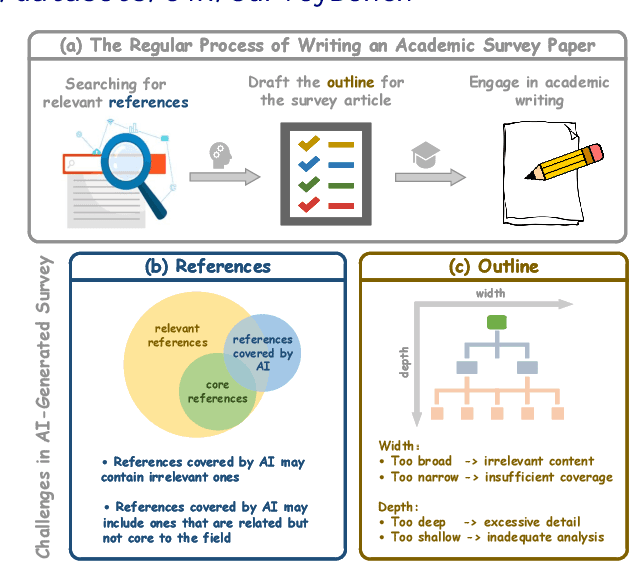



Abstract:Survey paper plays a crucial role in scientific research, especially given the rapid growth of research publications. Recently, researchers have begun using LLMs to automate survey generation for better efficiency. However, the quality gap between LLM-generated surveys and those written by human remains significant, particularly in terms of outline quality and citation accuracy. To close these gaps, we introduce SurveyForge, which first generates the outline by analyzing the logical structure of human-written outlines and referring to the retrieved domain-related articles. Subsequently, leveraging high-quality papers retrieved from memory by our scholar navigation agent, SurveyForge can automatically generate and refine the content of the generated article. Moreover, to achieve a comprehensive evaluation, we construct SurveyBench, which includes 100 human-written survey papers for win-rate comparison and assesses AI-generated survey papers across three dimensions: reference, outline, and content quality. Experiments demonstrate that SurveyForge can outperform previous works such as AutoSurvey.
Dolphin: Closed-loop Open-ended Auto-research through Thinking, Practice, and Feedback
Jan 07, 2025



Abstract:The scientific research paradigm is undergoing a profound transformation owing to the development of Artificial Intelligence (AI). Recent works demonstrate that various AI-assisted research methods can largely improve research efficiency by improving data analysis, accelerating computation, and fostering novel idea generation. To further move towards the ultimate goal (i.e., automatic scientific research), in this paper, we propose Dolphin, the first closed-loop open-ended auto-research framework to further build the entire process of human scientific research. Dolphin can generate research ideas, perform experiments, and get feedback from experimental results to generate higher-quality ideas. More specifically, Dolphin first generates novel ideas based on relevant papers which are ranked by the topic and task attributes. Then, the codes are automatically generated and debugged with the exception-traceback-guided local code structure. Finally, Dolphin automatically analyzes the results of each idea and feeds the results back to the next round of idea generation. Experiments are conducted on the benchmark datasets of different topics and results show that Dolphin can generate novel ideas continuously and complete the experiment in a loop. We highlight that Dolphin can automatically propose methods that are comparable to the state-of-the-art in some tasks such as 2D image classification and 3D point classification.
GeoX: Geometric Problem Solving Through Unified Formalized Vision-Language Pre-training
Dec 16, 2024



Abstract:Despite their proficiency in general tasks, Multi-modal Large Language Models (MLLMs) struggle with automatic Geometry Problem Solving (GPS), which demands understanding diagrams, interpreting symbols, and performing complex reasoning. This limitation arises from their pre-training on natural images and texts, along with the lack of automated verification in the problem-solving process. Besides, current geometric specialists are limited by their task-specific designs, making them less effective for broader geometric problems. To this end, we present GeoX, a multi-modal large model focusing on geometric understanding and reasoning tasks. Given the significant differences between geometric diagram-symbol and natural image-text, we introduce unimodal pre-training to develop a diagram encoder and symbol decoder, enhancing the understanding of geometric images and corpora. Furthermore, we introduce geometry-language alignment, an effective pre-training paradigm that bridges the modality gap between unimodal geometric experts. We propose a Generator-And-Sampler Transformer (GS-Former) to generate discriminative queries and eliminate uninformative representations from unevenly distributed geometric signals. Finally, GeoX benefits from visual instruction tuning, empowering it to take geometric images and questions as input and generate verifiable solutions. Experiments show that GeoX outperforms both generalists and geometric specialists on publicly recognized benchmarks, such as GeoQA, UniGeo, Geometry3K, and PGPS9k.
All-in-One: Transferring Vision Foundation Models into Stereo Matching
Dec 13, 2024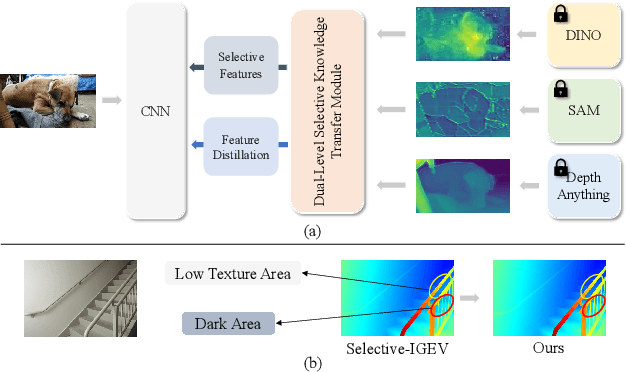

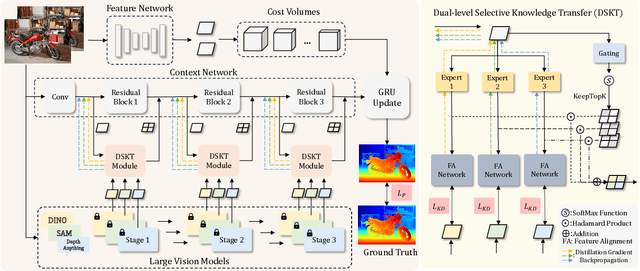

Abstract:As a fundamental vision task, stereo matching has made remarkable progress. While recent iterative optimization-based methods have achieved promising performance, their feature extraction capabilities still have room for improvement. Inspired by the ability of vision foundation models (VFMs) to extract general representations, in this work, we propose AIO-Stereo which can flexibly select and transfer knowledge from multiple heterogeneous VFMs to a single stereo matching model. To better reconcile features between heterogeneous VFMs and the stereo matching model and fully exploit prior knowledge from VFMs, we proposed a dual-level feature utilization mechanism that aligns heterogeneous features and transfers multi-level knowledge. Based on the mechanism, a dual-level selective knowledge transfer module is designed to selectively transfer knowledge and integrate the advantages of multiple VFMs. Experimental results show that AIO-Stereo achieves start-of-the-art performance on multiple datasets and ranks $1^{st}$ on the Middlebury dataset and outperforms all the published work on the ETH3D benchmark.
 Add to Chrome
Add to Chrome Add to Firefox
Add to Firefox Add to Edge
Add to Edge